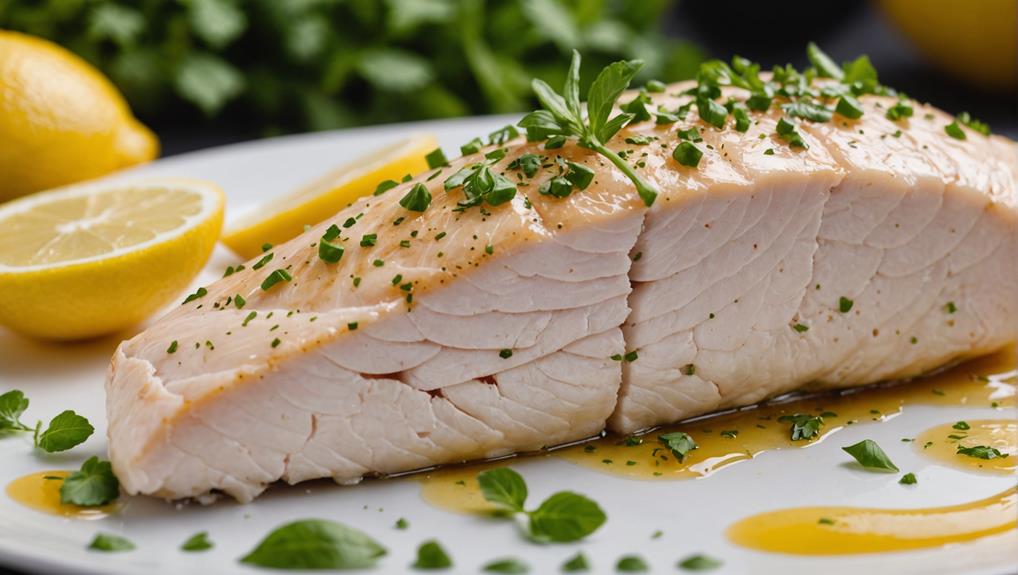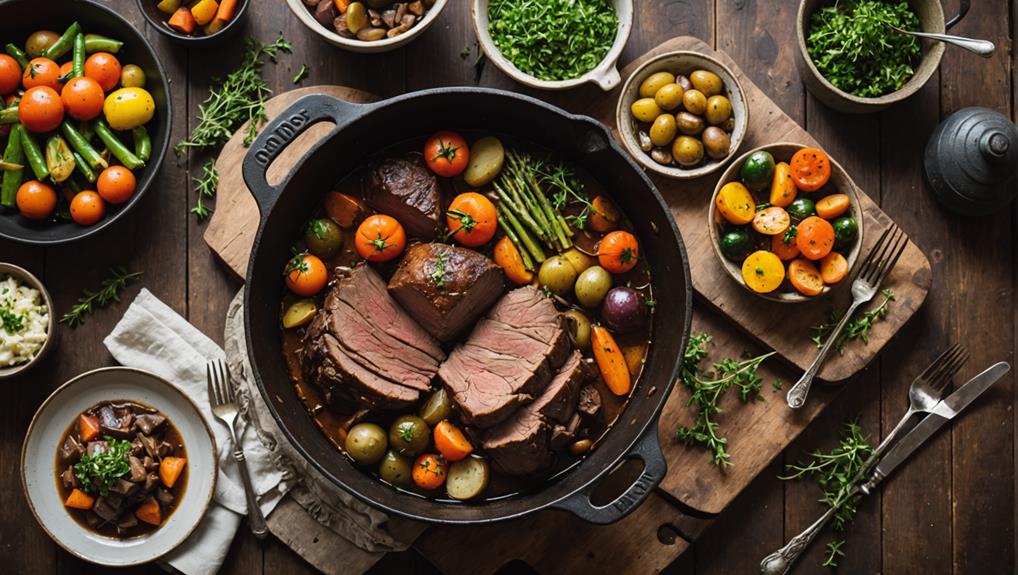When choosing between boiling and poaching, you'll find poaching to be the healthier option. This gentle cooking method preserves more nutrients, especially water-soluble vitamins and proteins, compared to boiling. Poaching also maintains the delicate flavors of foods like eggs, fish, and vegetables while infusing them with aromatic herbs and spices. It's a versatile technique that requires precise temperature control, typically between 160°F and 180°F, to ensure food safety and optimal texture. By opting for poaching, you'll create dishes that are not only nutritious but also moist and flavorful, without the need for added fats. Exploring this cooking method can open up a world of healthy culinary possibilities.
Understanding Boiling and Poaching
When it comes to cooking methods, boiling and poaching are two common techniques that often get confused. To distinguish between them, you'll need to understand their key differences.
Boiling involves immersing food in rapidly bubbling water at 212°F, while poaching uses gently simmering water at lower temperatures, typically between 160°F and 180°F.
You'll find that boiling is ideal for heartier foods like pasta and root vegetables, whereas poaching is perfect for delicate proteins such as eggs, fish, and chicken breasts. The gentle nature of poaching ensures even cooking and maintains a moist texture, reducing the risk of overcooking or drying out your food.
If you're health-conscious, you'll appreciate that poaching retains more vitamins and minerals compared to boiling, which can lead to nutrient loss. Additionally, poaching requires less heat and cooking time, making it a practical choice for quick, healthy meal preparation.
Nutrient Retention Comparison
When you're considering how to cook your food for maximum nutrition, it's important to understand the differences in nutrient retention between boiling and poaching.
You'll find that poaching generally preserves more vitamins and minerals, especially water-soluble nutrients like B vitamins and vitamin C, which can be lost in boiling water.
Proteins, too, are affected differently by these cooking methods, with poaching often resulting in a more tender texture and potentially higher retention of amino acids.
Vitamin and Mineral Preservation
Nutrient retention is a crucial factor when comparing boiling and poaching methods. When you're aiming to preserve vitamins and minerals in your food, poaching emerges as the superior technique. This innovative approach uses low temperatures and shorter cooking times, minimizing nutrient loss and maintaining the integrity of delicate nutrients like omega-3 fatty acids in fish.
Unlike boiling, which can strip away up to 50% of water-soluble nutrients, poaching retains over 90% of a food's nutritional value. This is particularly evident when preparing a poached egg, where the gentle cooking process preserves more vitamins and minerals compared to its boiled counterpart.
The same principle applies to vegetables; poaching allows them to retain their nutrients, while boiling often leaches these valuable components into the cooking water.
Protein Retention Differences
Delving into protein retention, poaching stands out as the superior method compared to boiling. When you're aiming to maximize the nutritional value of your meals, understanding the impact of cooking methods on protein content is crucial.
Poached foods retain approximately 90% of their protein content, while boiled items may lose around 10% due to nutrient migration into the cooking water. This significant difference can have a substantial impact on your overall nutrient intake.
The secret lies in the gentle cooking process of poaching. By maintaining temperatures between 160°F to 180°F, you're preserving delicate proteins that might otherwise become denatured at higher boiling temperatures.
This careful temperature control is particularly beneficial for protein-rich foods like eggs and chicken breasts. Poached chicken, for instance, has been shown to have a higher protein concentration than its boiled counterpart.
The difference stems from poaching's ability to minimize moisture loss and nutrient degradation during cooking. By opting for poaching over boiling, you're not only enhancing the protein content of your meals but also ensuring that you're getting the most nutritional bang for your buck.
Impact on Flavor Profiles
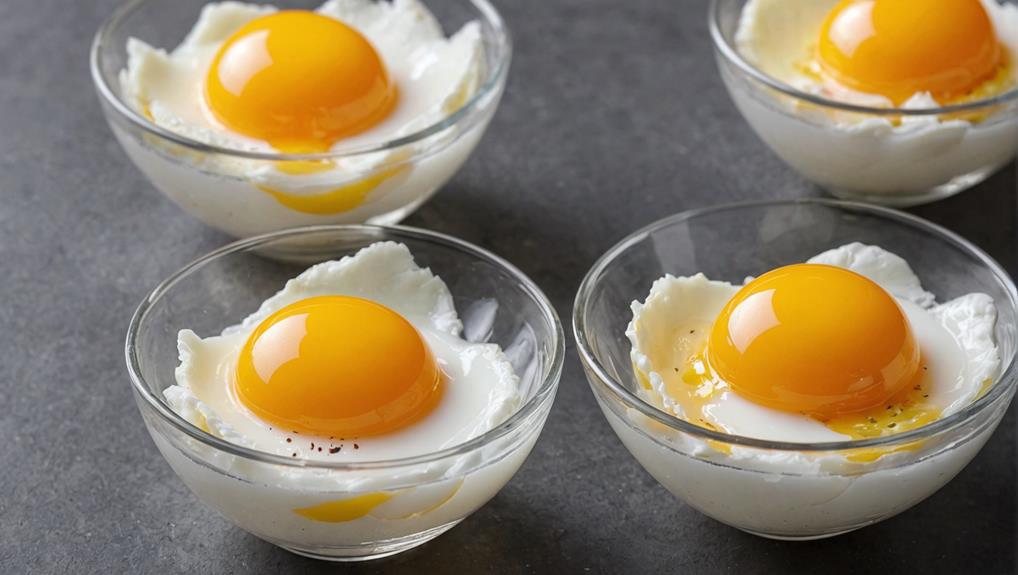
How does the cooking method affect the taste of your food? When it comes to poached versus boiled dishes, the impact on flavor profiles is significant.
Poaching, with its lower temperature and gentler approach, preserves the delicate flavors of your ingredients better than boiling.
This method allows you to:
- Maintain the rich, creamy taste of egg yolks
- Infuse subtle flavors from herbs and spices
- Absorb nuanced notes from flavored liquids like broth or wine
Preparation Techniques and Tips
Mastering the art of poaching and boiling requires attention to detail and a few key techniques. When preparing delicate foods like eggs, freshness is crucial. Always opt for fresh eggs to achieve the best texture and flavor in your poached or boiled creations.
For poaching, maintain water temperature between 180°F and 190°F using a thermometer. This prevents egg whites from becoming tough and ensures a perfectly cooked result. When boiling, keep the water at a gentle simmer rather than a rolling boil to preserve the integrity of delicate proteins.
To enhance your poaching technique, crack eggs into separate bowls before gently sliding them into the water. This reduces the risk of shell fragments and helps maintain the egg's shape.
For both methods, consider adding herbs, spices, or a splash of vinegar to the cooking water. This innovative approach infuses flavor without extra fats, making your poached or boiled dishes healthier and more exciting.
Food Safety Considerations
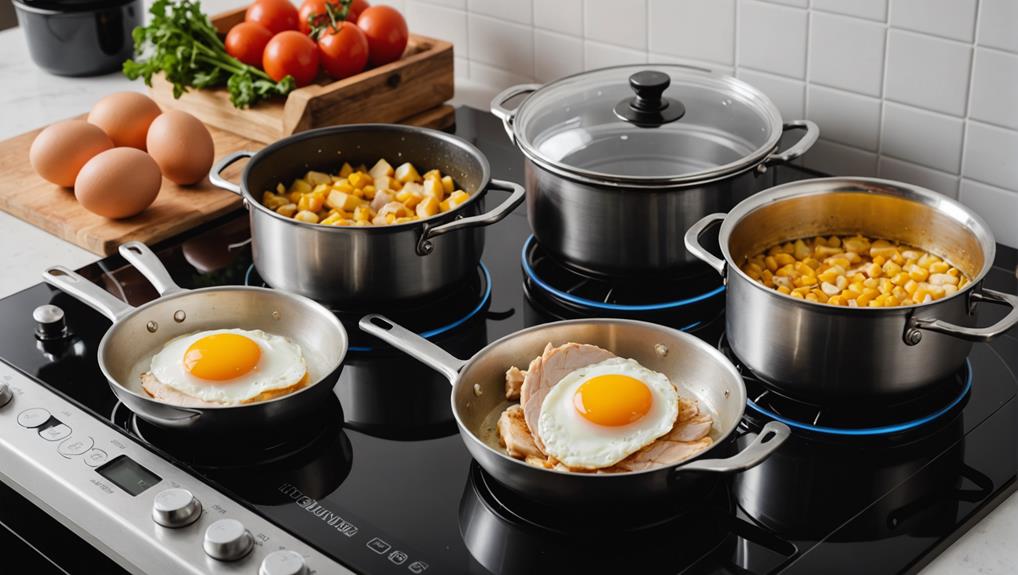
Ensuring food safety is paramount when boiling or poaching. These cooking methods require precise temperature control to eliminate harmful bacteria while preserving food quality. When preparing eggs, meat, or vegetables, you must adhere to specific guidelines to minimize health risks.
For optimal food safety:
- Use fresh, high-quality ingredients stored properly
- Sanitize all cooking equipment and surfaces
- Monitor internal temperatures with a reliable thermometer
When poaching eggs, maintain water temperature between 160°F and 180°F to retain moisture and kill bacteria. For meat, ensure it reaches an internal temperature of at least 165°F to effectively eliminate pathogens.
Vegetables should be cooked until tender in clean water, preserving nutrients while preventing bacterial growth.
To innovate your cooking process, consider investing in sous-vide equipment for precise temperature control. This method allows you to achieve consistent results while maintaining food safety standards.
Optimal Foods for Each Method
Which foods work best for boiling and poaching? When it comes to revolutionizing your cooking techniques, understanding the optimal foods for each method is crucial.
For poaching, you'll want to focus on delicate proteins that benefit from gentle heat. Poached eggs are a classic example, offering a silky texture and perfectly runny yolks. Fish, chicken breasts, and lean cuts like tenderloin also shine when poached, preserving moisture and enhancing flavors without added fat. This gentle method can be particularly effective for hearty dishes like Slow Cooker Chili Con Carne, where the slow infusion of spices creates a rich, comforting flavor profile.
Boiling, on the other hand, excels with starchy vegetables and pasta. Potatoes and noodles cook evenly in rapidly boiling water, ensuring consistent texture throughout. However, for nutrient retention, consider poaching vegetables like asparagus and carrots. You'll preserve vibrant colors and essential vitamins that might otherwise leach into boiling water.
When it comes to seafood, poaching is your go-to method. Lobster and salmon retain their delicate flavors and avoid the rubbery texture that can result from boiling.
Choosing the Healthier Cooking Approach
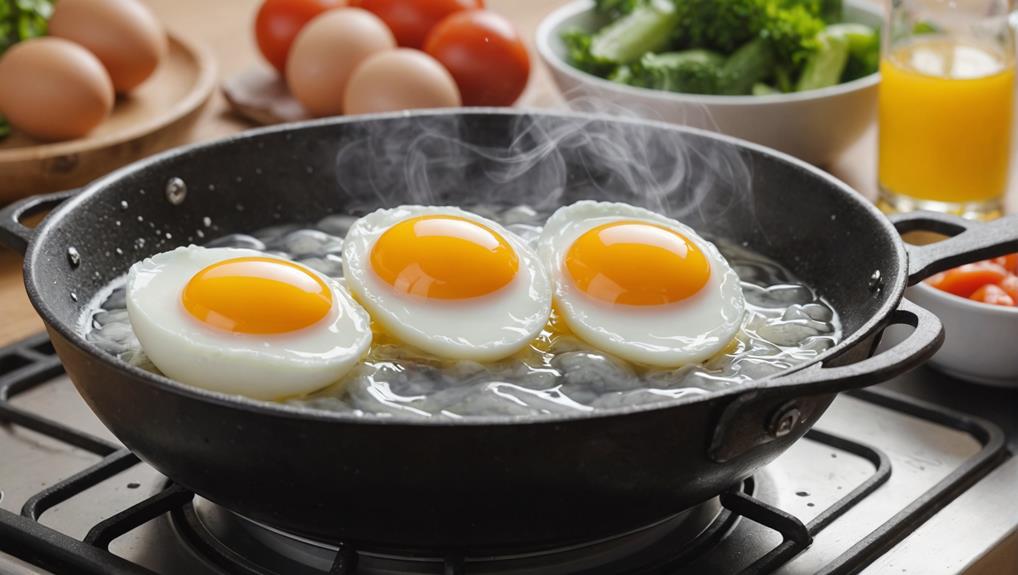
Now that we've explored the best foods for each method, let's consider how to choose the healthier cooking approach. When deciding between boiling and poaching, it's clear that poaching offers numerous health benefits. This gentle cooking technique preserves more nutrients, retains natural flavors, and requires no added fats.
Here's why poaching is often the healthier choice:
- It maintains food's moisture and tenderness, preventing proteins from toughening.
- The cooking liquid can be infused with herbs and spices, enhancing flavor without extra calories.
- It's ideal for heart-healthy diets, as it doesn't require additional oils or fats.
Poaching is an innovative cooking technique that aligns with modern health-conscious lifestyles. For example, poached eggs are a nutritious breakfast option that retains more vitamins compared to their boiled counterparts.
By choosing poaching over boiling, you're opting for a method that preserves essential nutrients and natural flavors while keeping calorie content low. This approach is particularly beneficial for those looking to maintain a balanced diet without sacrificing taste.
Frequently Asked Questions
What's Healthier, Boiled or Poached Eggs?
You'll find poached eggs slightly healthier than boiled ones. When comparing nutritional profiles and cooking techniques, poaching preserves more nutrients and moisture. It's an innovative way to enjoy eggs without added fats or harmful compounds.
Is Poaching Better Than Boiling?
You'll find poaching techniques gently caress your food, preserving nutrients and flavor. While boiling benefits shouldn't be dismissed, poaching's innovative approach offers a more tender, moist result. It's the cutting-edge choice for health-conscious culinary enthusiasts.
Is Poaching a Healthy Cooking Method?
You'll love poaching as a healthy cooking technique. It preserves nutritional benefits, keeps proteins tender, and infuses flavors without added fats. It's a innovative way to prepare meals that are both delicious and good for you.
Is Poaching the Healthiest Way to Cook Eggs?
You'll find poaching eggs is among the healthiest cooking techniques. It preserves egg nutrition, minimizes added fats, and maintains essential nutrients. While other methods have merits, poaching's gentle approach offers a cutting-edge, health-conscious way to prepare eggs.
Final Thoughts
You've now explored the nuances of boiling and poaching, equipping yourself with valuable knowledge to make healthier cooking choices. Remember, poaching can retain up to 90% of water-soluble vitamins, compared to boiling's 60-70%. As you apply these techniques, consider your nutritional goals, flavor preferences, and the specific foods you're preparing. By choosing the right method, you'll enhance both the taste and nutritional value of your meals, promoting better health through informed cooking practices.


